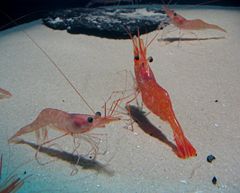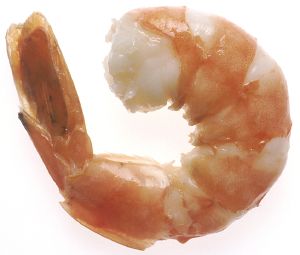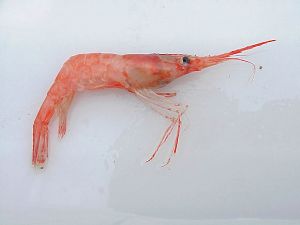Difference between revisions of "Shrimp" - New World Encyclopedia
({{Contracted}}) |
Rick Swarts (talk | contribs) |
||
| Line 1: | Line 1: | ||
{{Claimed}}{{Contracted}} | {{Claimed}}{{Contracted}} | ||
| + | {{Taxobox | ||
| + | | color = pink | ||
| + | | name = Shrimp | ||
| + | | image = Woda-6 ubt.jpeg | ||
| + | | image_width = 240px | ||
| + | | regnum = [[Animal]]ia | ||
| + | | phylum = [[Arthropod]]a | ||
| + | | subphylum = [[Crustacean|Crustacea]] | ||
| + | | classis = [[Malacostraca]] | ||
| + | | ordo = [[Decapoda]] | ||
| + | | subordo = [[Pleocyemata]] | ||
| + | | infraordo = '''Caridea''' | ||
| + | | infraordo_authority = [[James Dwight Dana|Dana]], 1852 | ||
| + | | subdivision_ranks = [[Superfamily|Superfamilies]] | ||
| + | | subdivision = | ||
| + | [[Alpheoidea]]<br /> | ||
| + | [[Atyoidea]]<br /> | ||
| + | [[Bresilioidea]]<br /> | ||
| + | [[Campylonotoidea]]<br /> | ||
| + | [[Crangonoidea]]<br /> | ||
| + | [[Galatheacaridoidea]]<br /> | ||
| + | [[Nematocarcinoidea]]<br /> | ||
| + | [[Oplophoroidea]]<br /> | ||
| + | [[Palaemonoidea]]<br /> | ||
| + | [[Pandaloidea]]<br /> | ||
| + | [[Pasiphaeoidea]]<br /> | ||
| + | [[Procaridoidea]]<br /> | ||
| + | [[Processoidea]]<br /> | ||
| + | [[Psalidopodoidea]]<br /> | ||
| + | [[Stylodactyloidea]] | ||
| + | }} | ||
| + | |||
| + | True '''shrimp''' are swimming, [[Decapoda|decapod]] [[crustacean]]s classified in the [[infraorder]] '''Caridea''', found widely around the world in both [[fresh water|fresh]] and [[seawater |salt water]]. Together with [[prawn]]s, they are widely caught and farmed for human consumption. | ||
| + | |||
| + | ==Taxonomy== | ||
| + | A number of more or less unrelated crustaceans share the word "shrimp" in their common name. Examples are the [[mantis shrimp]] and the opossum or [[mysid shrimp]], both of which belong to the same [[class (biology)|class]] ([[Malacostraca]]) as the true shrimp, but constitute two different [[order (biology)|order]]s within it, the [[Stomatopoda]] and the [[Mysidacea]]. ''Triops longicaudatus'' and ''Triops cancriformis'' are also popular animals in freshwater [[aquarium|aquaria]], and are often called shrimp, although they belong instead to the [[Notostraca]], a quite unrelated group. | ||
| + | |||
| + | Shrimp are distinguished from the superficially similar [[prawn]]s by the structure of the [[gill]]s, There is, however, much confusion between the two, especially among non-specialists, and many shrimp are called "prawns" and many prawns are called "shrimp". This is particularly widespread in culinary contexts. In [[Southeast Asia]], the difference between shrimp and prawns is based on size, with larger shrimp being called prawns.<ref>{{cite web|url=http://www.asiafood.org/glossary_2.cfm?wordid=2863|author=Charmaine Solomon|title=Encyclopedia of Asian Food|publisher=New Holland Publishers (Australia) Pty Ltd.|year=1998|accessdate=2006-09-16}}</ref> | ||
| + | |||
| + | ==Overview== | ||
| + | |||
| + | Brine shrimp comprise a [[genus]] with the subphylum [[Crustacea]], a group of [[arthropod]]s (phylum Arthropoda) that includes the familiar [[crab]]s, [[lobster]]s, [[shrimp]]s, [[barnacle]]s, [[copepod]]s, [[krill]], water fleas, and crayfish. Crustaceans are characterized by having branched (biramous) appendages, an exoskeleton made up of chitin and calcium, two pairs of [[antenna (biology)|antennae]] that extend in front of the mouth, and paired appendages that act like jaws, with three pairs of biting mouthparts. They share with other arthropods the possession of a segmented body, a pair of jointed appendages on each segment, and a hard exoskeleton that must be periodically shed for growth. | ||
| + | |||
| + | Brine shrimp belong to [[Brachiopoda]], one of the several classes of crustaceans that are recognized. Also included in this class are water fleas (''Daphnia'' sp.), and ''Triops'' (Notostraca). Within the Brachiopoda, brine shrimp are placed in the order Anostraca, the fairy shrimp. Although fairy shrimp and brine shrimp have the name "shrimp," they are not closely related to shrimp, which are placed in the crustacean class Malacostraca. (Some taxonomies consider Brachiopoda and Malacostraca to be orders.). Most fairy shrimp are small (under ½ inch, 1 centimeter), but the giant fairy shrimp ''Brachinecta gigas'' can reach over 6 inches (15 centimeters) and is predatory on other fairy shrimp. | ||
| + | |||
| + | |||
| + | ==Shrimp as food== | ||
| + | [[Image:NCI steamed shrimp.jpg|left|thumb|A steamed tail-on shrimp]] | ||
| + | {{Cookbook|shrimp}} | ||
| + | |||
| + | Recipes using shrimp form part of the [[cuisine|cuisine]] of many cultures: examples include shrimp kebabs, shrimp creole, shrimp gumbo, pan fried, deep fried, stir fried. There's pineapple shrimp and lemon shrimp, coconut shrimp, pepper shrimp, shrimp soup, shrimp stew, shrimp salad, shrimp and potatoes, shrimp burger, shrimp sandwich, shrimp fajitas. Strictly speaking, dishes containing [[scampi]] should be made from the [[Norway lobster]], a shrimp-like crustacean more closely related to the [[lobster]] than shrimp, but in some places it is quite common for large shrimp to be used instead. | ||
| + | |||
| + | As with other seafood, shrimp is high in [[calcium]] and [[protein]] but low in [[food energy]]. A shrimp-based meal is also a significant source of [[cholesterol]], from 7 [[milligram|mg]] to 251 mg per 100 [[gram|g]] of shrimp, depending on the method of preparation.<ref>{{cite web |url=http://www.dietaryfiberfood.com/cholesterol-shrimp.php |title=Cholesterol Content in Seafoods |accessmonthday=January 7 |accessyear=2007}}</ref> | ||
| + | |||
| + | Dried shrimp is commonly used as a flavoring and as a soup base in [[Asian cuisine]]s while fried shrimp is popular in North America. In Europe, shrimp is very popular, forming a necessary ingredient in Spanish [[paella|paella de marisco]], French [[bouillabaisse]], Italian [[cacciucco]], Portuguese [[caldeirada]] and many other seafood dishes. | ||
| + | |||
| + | Shrimp and other [[shellfish]] are among the most common [[food allergy|food allergens]].<ref>{{cite web | title = Common Food Allergens | url = http://www.foodallergy.org/allergens/index.html | publisher = The Food Allergy & Anaphylaxis Network | accessdate = 2007-06-24 }}</ref> | ||
| + | |||
| + | ===Shrimp or Prawns?=== | ||
| + | |||
| + | While in biological terms [[prawn]]s are of a distinct biological [[Order (biology)|suborder]] of [[Decapoda]], in commercial [[farming]] and [[fishery]] the terms shrimp and prawn are often used interchangeably. In European countries, particularly the [[United Kingdom]], the word “prawns” is more commonly on menus than the term “shrimp”, which is used more often in [[North America]]. The term “prawn” is also loosely used to describe any large shrimp, especially those that come 15 (or fewer) to the pound (also called “jumbo shrimp”). [[Australia]] and other [[Commonwealth of Nations|Commonwealth]] countries follow this European/British use to an even greater extent, using the word “prawn” almost exclusively. ([[Paul Hogan (actor)|Paul Hogan’s]] use of the phrase [[Shrimp on the barbie|“I'll slip an extra shrimp on the barbie for you”]] in a television advertisement was intended to make what he was saying easier for his American audience to understand, and was thus a deliberate distortion of what an Australian would typically say.) | ||
| + | |||
| + | ===Preparation=== | ||
| + | Preparing shrimp for consumption usually involves removing the [[Animal shell|shell]], [[tail]], and "sand vein". | ||
| + | |||
| + | To deshell a shrimp, the tail is held while gently removing the shell around the body. The tail can be detached completely at this point, or left attached for presentation purposes. | ||
| + | [[Image:Pandborealisind.jpg|thumb|right|''[[Pandalus borealis]]'']] | ||
| + | |||
| + | Removing the "vein" (a [[euphemism]] for the [[digestive tract]]) can be referred to as "[[devein|deveining]]", though in fact shrimp do not have any real [[vein]]s; they have an [[Circulatory system|open circulatory system]]. The "vein" can be removed by making a shallow cut lengthwise down the outer curve of the shrimp's body, allowing the dark ribbon-like digestive tract to be removed with a pointed utensil. Alternatively, if the tail has been detached, the vein can be pinched at the tail end and pulled out completely with the fingers. | ||
| + | |||
| + | The shrimp is then rinsed under cold running water. | ||
| + | |||
| + | ==Shrimp in aquaria== | ||
| + | Several types of shrimp are kept in home [[aquaria]]. Some are purely ornamental, while others are useful in controlling algae and removing debris.<ref name=kribshrimp>{{cite web|url=http://www.thekrib.com/Fish/Shrimp/|title=Freshwater Shrimp in the Aquarium|Publisher=The Krib|accessdate=2006-07-19|author=Anderson, Joe}}</ref> Freshwater shrimp commonly available for aquaria include the [[Caridina multidentata |Japanese marsh shrimp]] (''Caridina multidentata ,'' also called "Amano shrimp," as their use in aquaria was pioneered by [[Takashi Amano]]), and ghost or glass shrimp (''[[Palaemonetes]]'' spp.). Popular saltwater shrimp include the cleaner shrimp ''[[Lysmata amboinensis]]'', the [[fire shrimp]] (''Lysmata debelius'') and the [[Harlequin shrimp]] (''Hymenocera picta''). | ||
| + | |||
| + | ==See also== | ||
| + | * [[Shrimp farming]] | ||
| + | * [[Shrimp fishery]] | ||
| + | * [[Krill]] | ||
| + | * [[Dried shrimp]] | ||
| + | * [[Snapping shrimp]] | ||
| + | * [[Shrimp on the barbie]], an often-quoted phrase that originated in a series of television commercials by the Australian Tourism Commission starring Paul Hogan from 1986 | ||
| + | * ''[[The Shrimp Girl]]'' by [[William Hogarth]] | ||
| + | |||
| + | ==References== | ||
| + | {{reflist}} | ||
| + | |||
| + | ==External links== | ||
| + | |||
| + | *{{dmoz|Science/Biology/Flora_and_Fauna/Animalia/Arthropoda/Crustacea/Malacostraca/Decapoda/| Shrimp biology}} | ||
| + | |||
| + | |||
| + | [[Category:Life sciences]] | ||
| + | [[Category:Invertebrates]] | ||
| + | {{credit|Shrimp|172116807}} | ||
Revision as of 00:18, 19 November 2007
| Shrimp | ||||||||||||||
|---|---|---|---|---|---|---|---|---|---|---|---|---|---|---|
 | ||||||||||||||
| Scientific classification | ||||||||||||||
| ||||||||||||||
|
Alpheoidea |
True shrimp are swimming, decapod crustaceans classified in the infraorder Caridea, found widely around the world in both fresh and salt water. Together with prawns, they are widely caught and farmed for human consumption.
Taxonomy
A number of more or less unrelated crustaceans share the word "shrimp" in their common name. Examples are the mantis shrimp and the opossum or mysid shrimp, both of which belong to the same class (Malacostraca) as the true shrimp, but constitute two different orders within it, the Stomatopoda and the Mysidacea. Triops longicaudatus and Triops cancriformis are also popular animals in freshwater aquaria, and are often called shrimp, although they belong instead to the Notostraca, a quite unrelated group.
Shrimp are distinguished from the superficially similar prawns by the structure of the gills, There is, however, much confusion between the two, especially among non-specialists, and many shrimp are called "prawns" and many prawns are called "shrimp". This is particularly widespread in culinary contexts. In Southeast Asia, the difference between shrimp and prawns is based on size, with larger shrimp being called prawns.[1]
Overview
Brine shrimp comprise a genus with the subphylum Crustacea, a group of arthropods (phylum Arthropoda) that includes the familiar crabs, lobsters, shrimps, barnacles, copepods, krill, water fleas, and crayfish. Crustaceans are characterized by having branched (biramous) appendages, an exoskeleton made up of chitin and calcium, two pairs of antennae that extend in front of the mouth, and paired appendages that act like jaws, with three pairs of biting mouthparts. They share with other arthropods the possession of a segmented body, a pair of jointed appendages on each segment, and a hard exoskeleton that must be periodically shed for growth.
Brine shrimp belong to Brachiopoda, one of the several classes of crustaceans that are recognized. Also included in this class are water fleas (Daphnia sp.), and Triops (Notostraca). Within the Brachiopoda, brine shrimp are placed in the order Anostraca, the fairy shrimp. Although fairy shrimp and brine shrimp have the name "shrimp," they are not closely related to shrimp, which are placed in the crustacean class Malacostraca. (Some taxonomies consider Brachiopoda and Malacostraca to be orders.). Most fairy shrimp are small (under ½ inch, 1 centimeter), but the giant fairy shrimp Brachinecta gigas can reach over 6 inches (15 centimeters) and is predatory on other fairy shrimp.
Shrimp as food
Recipes using shrimp form part of the cuisine of many cultures: examples include shrimp kebabs, shrimp creole, shrimp gumbo, pan fried, deep fried, stir fried. There's pineapple shrimp and lemon shrimp, coconut shrimp, pepper shrimp, shrimp soup, shrimp stew, shrimp salad, shrimp and potatoes, shrimp burger, shrimp sandwich, shrimp fajitas. Strictly speaking, dishes containing scampi should be made from the Norway lobster, a shrimp-like crustacean more closely related to the lobster than shrimp, but in some places it is quite common for large shrimp to be used instead.
As with other seafood, shrimp is high in calcium and protein but low in food energy. A shrimp-based meal is also a significant source of cholesterol, from 7 mg to 251 mg per 100 g of shrimp, depending on the method of preparation.[2]
Dried shrimp is commonly used as a flavoring and as a soup base in Asian cuisines while fried shrimp is popular in North America. In Europe, shrimp is very popular, forming a necessary ingredient in Spanish paella de marisco, French bouillabaisse, Italian cacciucco, Portuguese caldeirada and many other seafood dishes.
Shrimp and other shellfish are among the most common food allergens.[3]
Shrimp or Prawns?
While in biological terms prawns are of a distinct biological suborder of Decapoda, in commercial farming and fishery the terms shrimp and prawn are often used interchangeably. In European countries, particularly the United Kingdom, the word “prawns” is more commonly on menus than the term “shrimp”, which is used more often in North America. The term “prawn” is also loosely used to describe any large shrimp, especially those that come 15 (or fewer) to the pound (also called “jumbo shrimp”). Australia and other Commonwealth countries follow this European/British use to an even greater extent, using the word “prawn” almost exclusively. (Paul Hogan’s use of the phrase “I'll slip an extra shrimp on the barbie for you” in a television advertisement was intended to make what he was saying easier for his American audience to understand, and was thus a deliberate distortion of what an Australian would typically say.)
Preparation
Preparing shrimp for consumption usually involves removing the shell, tail, and "sand vein".
To deshell a shrimp, the tail is held while gently removing the shell around the body. The tail can be detached completely at this point, or left attached for presentation purposes.
Removing the "vein" (a euphemism for the digestive tract) can be referred to as "deveining", though in fact shrimp do not have any real veins; they have an open circulatory system. The "vein" can be removed by making a shallow cut lengthwise down the outer curve of the shrimp's body, allowing the dark ribbon-like digestive tract to be removed with a pointed utensil. Alternatively, if the tail has been detached, the vein can be pinched at the tail end and pulled out completely with the fingers.
The shrimp is then rinsed under cold running water.
Shrimp in aquaria
Several types of shrimp are kept in home aquaria. Some are purely ornamental, while others are useful in controlling algae and removing debris.[4] Freshwater shrimp commonly available for aquaria include the Japanese marsh shrimp (Caridina multidentata , also called "Amano shrimp," as their use in aquaria was pioneered by Takashi Amano), and ghost or glass shrimp (Palaemonetes spp.). Popular saltwater shrimp include the cleaner shrimp Lysmata amboinensis, the fire shrimp (Lysmata debelius) and the Harlequin shrimp (Hymenocera picta).
See also
- Shrimp farming
- Shrimp fishery
- Krill
- Dried shrimp
- Snapping shrimp
- Shrimp on the barbie, an often-quoted phrase that originated in a series of television commercials by the Australian Tourism Commission starring Paul Hogan from 1986
- The Shrimp Girl by William Hogarth
ReferencesISBN links support NWE through referral fees
- ↑ Charmaine Solomon (1998). Encyclopedia of Asian Food. New Holland Publishers (Australia) Pty Ltd.. Retrieved 2006-09-16.
- ↑ Cholesterol Content in Seafoods. Retrieved January 7, 2007.
- ↑ Common Food Allergens. The Food Allergy & Anaphylaxis Network. Retrieved 2007-06-24.
- ↑ Anderson, Joe. Freshwater Shrimp in the Aquarium. Retrieved 2006-07-19.
External links
- Shrimp biology at the Open Directory Project
Credits
New World Encyclopedia writers and editors rewrote and completed the Wikipedia article in accordance with New World Encyclopedia standards. This article abides by terms of the Creative Commons CC-by-sa 3.0 License (CC-by-sa), which may be used and disseminated with proper attribution. Credit is due under the terms of this license that can reference both the New World Encyclopedia contributors and the selfless volunteer contributors of the Wikimedia Foundation. To cite this article click here for a list of acceptable citing formats.The history of earlier contributions by wikipedians is accessible to researchers here:
The history of this article since it was imported to New World Encyclopedia:
Note: Some restrictions may apply to use of individual images which are separately licensed.


